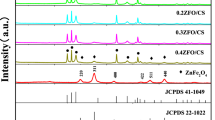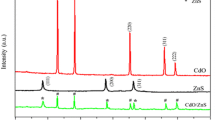Abstract
ZnWO4–CdS composite was designed and synthesized via a surface functionalized route under mild conditions. In this composite, CdS nanoparticle was successfully anchored on ZnWO4 nanorod with addition of citric acid. The formed composite was characterized by X-ray diffraction patterns, scanning electron microscopy, transmission electron microscopy, Brunauer–Emmett–Teller, photoluminescence and transient photocurrent response. Besides, a possible nucleation-growth mechanism was proposed. To explore the photocatalytic performance of as-prepared ZnWO4–CdS composite, methylene blue and ciprofloxacin were chosen as the representative to systematically assess the degradation ability of as-prepared composite under visible light irradiation. The obtained results indicate that the ZnWO4–CdS3 composite photocatalyst is more efficient to methylene blue and ciprofloxacin than others under same conditions. The greatly enhanced photocatalytic performance of ZnWO4–CdS composite can be attributed to larger specific surface area, wider photo adsorption range and higher photo-induced carriers separation efficiency. A reasonable mechanism of the enhanced photocatalytic activity was confirmed and demonstrated by a series of characterization methods.
Graphical Abstract

The formation of n-n heterojunction between ZnWO4 and CdS can effectively promote the separation and transfer efficiency of photo-generated carriers and enhance the photocatalytic performance of composite.













Similar content being viewed by others
References
Wu L, Bresser D, Buchholz D, Giffin G, Castro C, Ochel A, Passerini S (2015) Unfolding the mechanism of sodium insertion in anatase TiO2 nanoparticles. Adv Energy Mater 5:1401142
Wang Y, Song S, Liu J, Liu D, Zhang H (2015) ZnO-functionalized upconverting nanotheranostic agent: multi-modality imaging-guided chemotherapy with on-demand drug release triggered by pH. Angew Chem Int Ed 54:536–540
Wang Q, Li J, Bai Y, Lian J, Huang H, Li Z, Lei Z, Shangguan W (2014) Photochemical preparation of Cd/CdS photocatalysts and their efficient photocatalytic hydrogen production under visible light irradiation. Green Chem 16:2728–2735
Xu W, Zheng C, Hua H, Yang Q, Chen L, Xi Y, Hu C (2015) Synthesis and photoelectrochemical properties of CdWO4 and CdS/CdWO4 nanostructures. Appl Surf Sci 327:140–148
Xu L, Huang W, Wang L, Tian Z, Hu W, Ma Y, Wang X, Pan A, Huang G (2015) Insights into enhanced visible-light photocatalytic hydrogen evolution of g-C3N4 and highly reduced graphene oxide composite: the role of oxygen. Chem Mater 27:1612–1621
Kumar S, Koteswara R (2015) Tungsten-based nanomaterials (WO3 & Bi2WO6): modifications related to charge carrier transfer mechanisms and photocatalytic applications. Appl Surf Sci 355:939–958
Liu J, Liu Y, Liu N, Han Y, Zhang X, Huang H, Lifshitz Y, Lee S, Zhong J, Kang Z (2015) Metal-free efficient photocatalyst for stable visible water splitting via a two-electron pathway. Science 347:970–974
Iwashina K, Iwase A, Ng Y, Amal R, Kudo A (2015) Z-schematic water splitting into H2 and O2 using metal sulfide as a hydrogen-evolving photocatalyst and reduced graphene oxide as a solid-state electron mediator. J Am Chem Soc 137:604–607
Pan C, Takata T, Nakabayashi M, Matsumoto T, Shibata N, Ikuhara Y, Domen Y (2015) A complex perovskite-type oxynitride: the first photocatalyst for water pplitting operable at up to 600 nm. Angew Chem Int Ed 54:2955–2959
Feng K, Huang S, Lou Z, Zhu N, Yuan H (2015) Enhanced photocatalytic activities of the heterostructured upconversion photocatalysts with cotton mediated on TiO2/ZnWO4: Yb3+, Tm3+. Dalton Trans 44:13681–13687
Su Y, Zhu B, Guan K, Gao S, Lv L, Du C, Peng L, Hou L, Wang X (2012) Particle size and structural control of ZnWO4 nanocrystals via Sn2+ doping for tunable optical and visible photocatalytic properties. J Phys Chem C 116:18508–18517
Arin J, Dumrongrojthanath P, Yayapao O, Phuruangrat A, Thongtem S, Thongtem T (2014) Synthesis, characterization and optical activity of La-doped ZnWO4 nanorods by hydrothermal method. Superlattices Microstruct 67:197–206
Song X, Zheng Y, Yang E, Liu G, Zhang Y, Chen H, Zhang Y (2010) Photocatalytic activities of Cd-doped ZnWO4 nanorods prepared by a hydrothermal process. J Hazard Mater 179:1122–1127
Huang G, Zhu Y (2012) Synthesis and photoactivity enhancement of ZnWO4 photocatalysts doped with chlorine. CrystEngComm 14:8076–8082
Lin J, Lin J, Zhu Y (2007) Controlled synthesis of the ZnWO4 nanostructure and effects on the photocatalytic performance. Inorg Chem 46:8372–8378
Zhang C, Zhang H, Zhang K, Li X, Leng Q, Hu C (2014) Photocatalytic activity of ZnWO4: band structure, morphology and surface modification. ACS Appl Mater Interfaces 6:14423–14432
Amouzegara Z, Naghizadeha R, Rezaiea H, Ghaharic M, Aminzarea M (2015) Microwave engineering of ZnWO4 nanostructures: towards morphologically favorable structures for photocatalytic activity. Ceram Int 41:8352–8359
Keereeta Y, Thongtem S, Thongtem T (2015) Enhanced photocatalytic degradation of methylene blue by WO3/ZnWO4 composites synthesized by a combination of microwave-solvothermal method and incipient wetness procedure. Powder Technol 284:85–94
Zhao X, Yao W, Wu Y, Zhang S, Yang H, Zhu Y (2006) Fabrication and photoelectrochemical properties of porous ZnWO4 film. J Solid State Chem 179:2562–2570
Zhan S, Zhou F, Huang N, Yang Y, Liu Y, Yin Y, Fang Y (2015) g-C3N4/ZnWO4 films: preparation and its enhanced photocatalytic decomposition of phenol in UV. Appl Surf Sci 358:328–335
Leonard K, Nam K, Lee H, Kang S, Park H, Bard A (2013) ZnWO4/WO3 composite for improving photoelectrochemical water oxidation. J Phys Chem C 117:15901–15910
Guan B, Hu L, Zhang G, Guo D, Fu T, Li J, Duan H, Li C, Li Q (2014) Facile synthesis of ZnWO4 nanowall arrays on Ni foam for high performance supercapacitors. RSC Adv 4:4212–4217
Hamrouni A, Moussa N, Paola A, Parrino F, Houas A, Palmisano L (2014) Characterization and photoactivity of coupled ZnO-ZnWO4 catalysts prepared by a sol-gel method. Appl Catal, B 154–155:379–385
Chen X, Shen S, Guo L, Mao S (2010) Semiconductor-based photocatalytic hydrogen generation. Chem Rev 110:6503–6570
Feng Y, Yan X, Liu C, Hong Y, Zhu L, Zhou M, Shi W (2015) Hydrothermal synthesis of CdS/Bi2MoO6 heterojunction photocatalysts with excellent visible-light-driven photocatalytic performance. Appl Surf Sci 353:87–94
Jin J, Yu J, Guo D, Cui C, Ho W (2015) A hierarchical Z-scheme CdS-WO3 photocatalyst with enhanced CO2 reduction activity. Small 11:5262–5271
Wang Q, Lian J, Li J, Wang R, Huang H, Su B, Lei Z (2015) Highly efficient photocatalytic hydrogen production of flower-like cadmium sulfide decorated by histidine. Sci Rep 5:13593
Huo P, Tang Y, Zhou M, Li J, Ye Z, Ma C, Yu L, Yan Y (2016) Fabrication of ZnWO4-CdS heterostructure photocatalysts for visible light induced degradation of ciprofloxacin antibiotics. J Ind Eng Chem 37:340–346
Li D, Xue J, Bai X (2016) Synthesis of ZnWO4/CdWO4 core-shell structured nanorods formed by an oriented attachment mechanism with enhanced photocatalytic performances. CrystEngComm 18:309–315
Huang G, Zhang C, Zhu Y (2007) ZnWO4 photocatalyst with high activity for degradation of organic contaminants. J Alloys Compd 432:269–276
Wang L, Wang W (2012) In situ synthesis of CdS modified CdWO4 nanorods and their application in photocatalytic H2 evolution. CrystEngComm 14:3315–3320
Wang Q, Hui J, Huang Y, Ding Y, Cai Y, Yin S, Li Z, Su B (2014) The preparation of BiOCl photocatalyst and its performance of photodegradation on dyes. Mater Sci Semicond Process 17:87–93
Lai J, Qin Y, Yu L, Zhang C (2016) GSH-assisted hydrothermal synthesis of MnxCd1-xS solid solution hollow spheres and their application in photocatalytic degradation. Mater Sci Semicond Process 52:82–90
Wu D, Huo P, Lu Z, Gao X, Liu X, Shi W, Yan Y (2012) Preparation of heteropolyacid/TiO2/fly-ash-cenosphere photocatalyst for the degradation of ciprofloxacin from aqueous solutions. Appl Surf Sci 258:7008–7015
Shi Y, Yang Z, Liu Y, Yu J, Wang F, Tong J, Su B, Wang Q (2016) Fabricating a g-C3N4/CuOx heterostructure with tunable valence transition for enhanced photocatalytic activity. RSC Adv 6:39774–39783
Xu M, Ye T, Dai F, Yang J, Shen J, He Q, Chen W, Liang N, Zai J, Qian X (2015) Rationally designed n-n heterojunction with highly efficient solar hydrogen evolution. ChemSusChem 8:1218–1225
Park H, Kim H, Moon G, Choi W (2016) Photoinduced charge transfer processes in solar photocatalysis based on modified TiO2. Energy Environ Sci 9:411–433
Wang Q, Shi Y, Du Z, He J, Zhong J, Zhao L, She H, Liu G, Su B (2015) Synthesis of rod-like g-C3N4/ZnS composites with superior photocatalytic activity for the degradation of methyl orange. Eur J Inorg Chem 2015:4108–4115
Wang Q, Shi Y, Sun Y, She H, Yu J, Yang Y (2017) Designed C3N4/CdS-CdWO4 core-shell heterostructure with excellent photocatalytic activity. New J Chem 41:1028–1036
Khanchandani S, Kundu S, Patra A, Ganguli A (2012) Shell thickness dependent photocatalytic properties of ZnO/CdS core-shell nanorods. J Phys Chem C 116:23653–23662
Acknowledgements
This work was financially supported by the National Natural Science Foundation of China (21663027, 51262028, 21261021), the Science and Technology Support Project of Gansu Province (1504GKCA027), the Program for the Young Innovative Talents of Longyuan, the Program for Innovative Research Team (NWNU-LKQN-15-2), the Opening Project of Key Laboratory of Green Catalysis of Sichuan Institutes of High Education (LZJ1502), the Research Fund for Higher Education of Gansu Province (2016A-002) and the Undergraduate Academic Innovative Research Team of Northwest Normal University.
Author information
Authors and Affiliations
Corresponding author
Ethics declarations
Conflict of interest
The authors declare that they have no competing interests.
Electronic supplementary material
Rights and permissions
About this article
Cite this article
Wang, Q., Shi, Y., Niu, T. et al. Preparing ZnWO4–CdS composite with excellent visible light photocatalytic activity under mild conditions. J Sol-Gel Sci Technol 83, 555–566 (2017). https://doi.org/10.1007/s10971-017-4434-8
Received:
Accepted:
Published:
Issue Date:
DOI: https://doi.org/10.1007/s10971-017-4434-8




